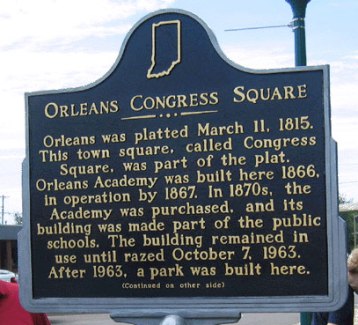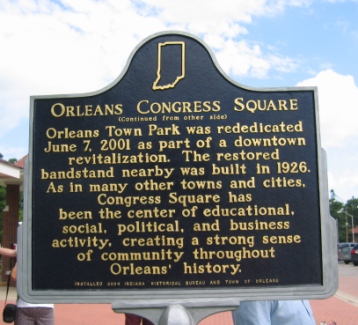

Location: East side of Congress Square, Veterans Way Street, Orleans. (Orange County, Indiana)
Installed: 2004 Indiana Historical Bureau and Town of Orleans
ID# : 59.2004.1
Text
Side one:
Orleans was platted March 11, 1815. This town square, called Congress Square, was part of the plat. Orleans Academy was built here 1866, in operation by 1867. In 1870s, the Academy was purchased, and its building was made part of the public schools. The building remained in use until razed October 7, 1963. After 1963, a park was built here.
Side two:
Orleans Town Park was rededicated June 7, 2001 as part of a downtown revitalization. The restored bandstand nearby was built in 1926. As in many other towns and cities, Congress Square has been the center of educational, social, political, and business activity, creating a strong sense of community throughout Orleans' history.
Keywords
Historic District, Neighborhoods, and Towns, Early Settlement and Exploration
Annotated Text
Orleans was platted March 11, 1815.(1) This town square, called Congress Square, was part of the plat.(2) Orleans Academy was built here 1866, in operation by 1867.(3) In 1870s, the Academy was purchased, and its building was made part of the public schools.(4) The building remained in use until razed October 7, 1963.(5) After 1963, a park was built here.(6)
Orleans Town Park was rededicated June 7, 2001 as part of a downtown revitalization.(7) The restored bandstand nearby was built in 1926.(8) As in many other towns and cities, Congress Square has been the center of educational, social, political, and business activity, creating a strong sense of community throughout Orleans' history.(9)
Notes:
(1)1815 plat map. Washington County was organized 1814. George Pence and Nellie C. Armstrong, Indiana Boundaries: Territory, State, and County (Indianapolis, 1933), 820. In 1816, Orange County was organized from that part of Washington County, which included Orleans. Pence and Armstrong, 636.
(2)1815 Plat map. "Congress square is composed of Lots Nos. 167, 168, 169, 170, 195, 196, 197, and 198 to remain for the purpose erecting any buildings, for County, Territory, or State purpose or deemed necessary by the citizens of the town . . . . No part of Congress square ever to be appropriated as a burying grounds." Sanborn-Perris Map, Sanborn-Perris Map Co., Limited (New York, August, 1895). Lot numbers are not given for the square itself on this map; note lot numbers around square. Congress is defined as, "The act of coming together: MEETING." Houghton Mifflin College Dictionary (Boston, 1986), 298.
(3)Claude E. Cogswell, "Brief History of the School System of Orange County, " State of Indiana, Department of Public Instruction, Twenty-eighth Biennial Report of the State Superintendent of Public Instruction (Fort Wayne, 1917), 436; Advertisement for the school, Paoli American Eagle, September 12, 1867; Lewis Alvin Curtis Ralston, History of the Orange County Schools, M.A. Thesis, Indiana University, 1932, 102.
According to Goodspeed Publishing Company, History of Lawrence, Orange, and Washington Counties of Indiana (Chicago, 1884; Reprint, Stouts Print Shop, Paoli, 1965), 557, "In 1831 the citizens, under the leadership of Joseph Crawford and John Sears, built a schoolhouse on the public square, where the school building now [1884] stands." No other evidence of this school has been found.
" . . .the organization and establishment of schools was very slow. Very little was done until after 1840 . . . there was a strong sentiment in the county that the public should not be taxed for the support of the schools . . . . But in many townships no money could be raised by taxation for erecting buildings until the law of 1852 giving trustees power to levy these taxes without consent of the people. . . . By the year 1857, free schools were well under way in all townships of the county." Cogswell, 435.
(4)Cogswell, 436; Ralston, 102; Goodspeed, 558.
(5)Orleans Progress-Examiner, October 10, 1963, June 15, 1911, September 2, 1926. On September 5, 1963, a new elementary school opened at 635 East Washington Street. "All interested patrons and friends are invited to view this new building which is replacing the old school building located on the Public Square. The first unit of this old building . . . has been in continuous use until its replacement this year." Orleans Progress-Examiner, September 5, 1963.
(6)In October, 1963, the Orleans Town Board began a movement to build a city park where the school once stood.
Orleans Progress-Examiner, October 17, 1963. "The members of the Town Board of Orleans have asked the civic organizations of the town to suggest means of utilizing the square when the old school building is cleared away . . .
"Let's keep this attractive appearance intact by placing a Park in the Square." Newspaper articles show the progression of the project, "City Park on Square—1964" file at Indiana Historical Bureau.
(7)In 1966, Operation Dogwood was launched by Elizabeth Turner Wheeler. Orleans Progress-Examiner, April 22, 1978, "History of the Dogwood Festival, " Special Edition, Welcome to the 1978 Orleans Dogwood Festival", 2. ". . .members of "Operation Dogwood" have set out hundreds of trees in public parks, cemeteries, along roads and streets. They have gone into woods, dug up and transplanted the wild white dogwoods." In April 1970, Orleans held the first annual Dogwood Festival. Orleans Progress-Examiner, April 30, 1970. The festival was originally begun in 1968 but the one-day event was rained out. No attempt was made to continue the festival until 1970. Orleans Progress-Examiner, April 2000 (Special Edition, "Blooming into the Millennium"), 22. Orleans Progress-Examiner, April 28, 1999. On October 26, 1970, Governor Edgar Whitcomb issues a proclamation naming Orleans the "Dogwood Capital of Indiana." "Blooming in the Millennium, " 23; copy of October 26, 1970 Proclamation.
Starting in 1998 and 1999, Orleans began receiving monies to support the planned revitalization of its downtown. Orleans Progress Examiner, March 11, April 8, 1998; Orleans Progress-Examiner, March 18, 1998; Orleans Progress-Examiner, June 9, 1999; Orleans Progress-Examiner, June 23, 1999. Orleans raised $106, 000 in pledges for matching funds for grants. Orleans Progress-Examiner, March 10, 1999.
In April 2000, Orleans received bids for the downtown project. Orleans Progress-Examiner, April 19, 2000. On June 5, 2000, Orleans broke ground for revitalization project. Orleans Progress-Examiner, June 7, 2000. On June 7, 2001, the revitalization, including Orleans Town Park on Congress Square is rededicated. Orleans Progress-Examiner, June 7, 13, 2001.
In May 2002, Orleans received the "Community Legacy Award" presented by Historic Southern Indiana for its downtown revitalization project. Orleans Progress-Examiner, May 2002.
Indiana 2016 featured Orleans in its Monthly Community Spotlight, accessed July 17, 2003.
(8)The bandstand was built on the square and band concerts were held. Orleans Progress-Examiner, June 10, 1926; Orleans Progress-Examiner, October 4, 2000; South Central Indiana's Business Journal, July 2001.
(9) A sampling of reports demonstrates the square's importance. On July 4, 1839—Paoli The True American, July 12, 1839. "Upwards of six thousand persons were supposed to have been present. . . This immense concourse assembled at 10 o'clock in the morning, on the square . . . and were marched from thence to a beautiful grove adjoining town." Speech in 1888 by Republican nominee for president, Benjamin Harrison—Indianapolis News, November 3, 1952. Author Wayne Guthrie received a written account of this event by Mrs. George F. Ham, of Paoli. "The ‘speakin' was held from a flag-draped platform set up in the school yard in the center of the town. And available space around it was really packed with people." George F. Ham and his wife Nellie E. Ham are listed in Paoli Township in the 1900 census. Nellie was born in 1876, making her twelve years old at the time Harrison visited.
In 1897, fire destroyed buildings/businesses on north-east of square. Townspeople gather on the square and work together during the disaster. Orleans Progress, April 22, 1897 describes the fire. 1895 Sanborn-Perris Map indicates that the north-east side was the main business area.
On July 4, 1899, 10, 000 people attend the celebration. Orleans Progress, July 4, 1899. On August 18, 1899, a reunion of Civil War veterans was held. Orleans Progress, August 24, 1899. On May 5, 1905, Orleans got electricity, and a celebration was held in the square. Orleans Progress-Examiner, May 11, 1905 states, "Downtown streets were crowded with the towns-folk to see the illumination." Orleans celebrated its centennial March 15, 1915. Orleans Progress-Examiner, March 11, 1915.
In August 1965, Orleans celebrates its sesquicentennial with a week of planned events. Orleans Progress—Examiner, August 19, 1965. March 15, 1990, Orleans celebrates its dodrabicentennial (175). Orleans Progress-Examiner, March 14, 1990.
